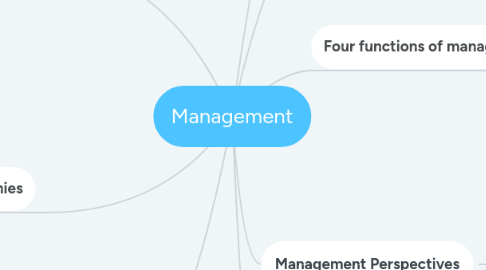
1. Competitive strategies
1.1. Low cost
1.1.1. Efficent instalations and rigid production control to lower costs.
1.2. Differentiation
1.2.1. Differs from competition, hence loyal customers.
1.3. Focus
1.3.1. Focusing on a regional market, or group of buyers.
2. Tools for analyzing companies
2.1. SWOT
2.1.1. Strengths (Internal of the company)
2.1.2. Weaknesses (Internal of the company)
2.1.3. Opportunities (External of the company)
2.1.4. Threats (External of the company)
2.2. Porter 5 forces
2.2.1. Rivalry among existing competitors.
2.2.2. Threat of new entrants.
2.2.3. Bargaining power of suppliers.
2.2.4. Bargaining power of buyers.
2.2.5. Threat of substitute products.
3. Megatrends
3.1. Globalization
3.1.1. Going global with one big company.
3.2. Globularization
3.2.1. Going global through a network of entrepreneurial collaborative companies.
3.3. Materialization
3.3.1. Digitalization of products.
4. What is management?
4.1. The organization and coordination of the activities of a business in order to achieve defined objectives.
5. Management types
5.1. Vertical
5.1.1. Top managers: Responsible for the entire organization. Middle managers: Responsible for business units and major departments. Project managers: Responsible for temporary work projects involving people from different levels and companies. First-line managers: Responsible for production of goods and services
5.2. Horizontal
5.2.1. Functional managers: Responsible for departments that perform a single task General managers: Responsible for several departments that perform different functions.
6. Four functions of management
6.1. Planning
6.1.1. Choosing tasks that must be performed to attain organizational goals, outlining how the tasks must be performed, and indicating when they should be performed.
6.2. Organizing
6.2.1. Assigning the tasks developed in the planning stages, to various individuals or groups within the organization.
6.3. Leading
6.3.1. Motivating employees, directing the activities of others, selecting the most effective communication channel, and resolving conflicts.
6.4. Controlling
6.4.1. Monitoring performance, comparing it with goals, and correcting any significant deviations.
7. Management Perspectives
7.1. Classical perspective
7.1.1. Focus on producing as much goods as possible.
7.2. Humanistic perspective
7.2.1. Understanding human behaviors, needs, and attitudes in the workplace.
7.3. Systems thinking
7.3.1. Seeing the organization as a whole and understanding the interrelationships in it.
7.4. Contingency view
7.4.1. Every situation is a new one, therefore a different approach must be taken.
7.5. New technology driven
7.5.1. Focus on technological skills such as working with and analyzing data.
7.6. New people-driven
7.6.1. Boss less, social media influenced workers.
8. Planning tools
8.1. Mission statement
8.1.1. Broadly stated definition of purpose that distinguishes the organization from others of a similar type.
8.2. Strategic goals
8.2.1. Official goals; broad statements describing where the organization wants to be in the future.
8.3. Strategic plans
8.3.1. Define the action steps by which the company intends to attain strategic goals.
8.4. Tactical goals
8.4.1. The results that major divisions and departments within the organization intend to achieve.
8.5. Tactical plans
8.5.1. Define what major departments and organizational subunits will do to implement the organization’s strategic plan.
8.6. Operational goals
8.6.1. Specific results expected from departments, work groups, and individuals.
8.7. Operational plans
8.7.1. Specify action plans toward achieving operational goals and to support tactical plans.
